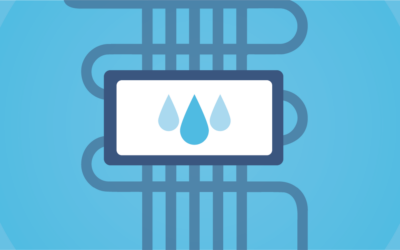When designing a variable volume chilled water system, there are two main types of distribution systems to choose from: a Variable/Primary system or a Primary/Secondary system. Both options are effective means for hydronic distribution for most building types with each system having some advantages and disadvantages as compared to the other. This blog will focus on Primary/Secondary Systems.
The Origins of the Primary/Secondary Chilled Water Distribution System
The concept of Primary/Secondary pumping can be traced back to the mid-20th century when advancements in HVAC technology and the increasing complexity of building heating and cooling requirements necessitated more sophisticated system designs. Engineers and HVAC professionals recognized the limitations of single-loop systems, particularly in large-scale applications, and began exploring ways to decouple the flow requirements of different parts of the system to optimize performance.
One significant figure in the development and popularization of primary/secondary hydronic systems is Gil Carlson, often referred to as the “father of modern hydronics.” Carlson, an engineer at Bell & Gossett, made significant contributions to the understanding and design of hydronic systems. His work in the mid-20th century laid the foundation for many modern hydronic practices, including the use of primary/secondary piping configurations.
Bell & Gossett, a major manufacturer of pumps and hydronic system components, played a crucial role in disseminating knowledge about primary/secondary systems. Through publications, seminars, and technical guides, the company helped educate engineers and contractors about the benefits and implementation of Primary/Secondary configurations.
Primary/Secondary Chilled Water Distribution System Components
The Primary/Secondary configuration was designed to enhance the efficiency and flexibility of hydronic cooling systems. The Primary/Secondary chilled water configuration comprises two interconnected loops: the primary loop, which circulates chilled water between the chiller and the secondary loop, and the secondary loop, which distributes chilled water to various loads throughout the building or facility. These loops are connected via a common pipe, often referred to as a decoupler or bypass.
Primary Chilled Water Loop
The primary loop encompasses the chillers and is responsible for maintaining a constant flow rate through them. This steady flow ensures that the chillers operate within their optimal performance range, which is crucial for maximizing efficiency and minimizing wear and tear. The primary loop’s constant flow is independent of the cooling load demand, providing a stable environment for the chillers.
Secondary Chilled Water Loop
The secondary loop serves the cooling loads of the building, such as air handling units and fan coil units. Unlike the primary loop, the flow rate in the secondary loop is variable, adjusting to meet the cooling demand of the building. The secondary loop utilizes variable volume pumps to pull the chilled water from the primary loop and distribute it to the system.
Primary/Secondary operation is based on this basic rule: when two circuits are interconnected, flow in one will not cause flow in the other if the pressure drop in the piping common to both is eliminated. Therefore, a differential pressure sensor located near the end of the system piping will direct the pump(s) to increase or decrease the flow to satisfy the system.
Chilled Water Bypass Valve or Decoupler
The key to all primary/secondary applications is the use of a common pipe, or decoupler, which interconnects the primary and secondary loops. The decoupler allows for hydraulic separation between the primary and secondary loops so that changes in flow rate and pressure in the secondary loop do not directly affect the primary loop, and vice versa.
This separation ensures that the primary loop can maintain a constant flow rate through the chillers, while the secondary loop can adjust its flow rate to meet varying cooling demands without causing hydraulic imbalances.
The decoupler also aids balancing the flow rates between the two loops. It provides a path for excess flow from the primary loop to return to the chillers when the secondary loop requires less flow, and vice versa. This balancing act is crucial for preventing issues such as low flow conditions in the chillers, which can lead to inefficient operation and potential equipment damage.
Advantages of a Primary/Secondary Chilled Water Distribution System
One of the key advantages of this configuration is its ability to accommodate varying load demands efficiently. By decoupling the primary and secondary loops, the system can maintain a constant flow rate and temperature in the primary loop, regardless of fluctuations in the secondary loop. This ensures that the chiller operates at optimal conditions, maximizing energy efficiency and minimizing wear and tear on the equipment.
Additionally, the Primary/Secondary configuration offers flexibility and redundancy, allowing for easier maintenance and troubleshooting. In the event of maintenance or repair needs in the secondary loop, the primary loop can continue to operate independently, ensuring uninterrupted cooling provision to critical loads.
Disadvantages of a Primary/Secondary Chilled Water Distribution System
The main shortcoming of the Primary/Secondary system layout is wasted energy. The constant speed constant flow is designed to address conditions on the hottest day of year, creating inadequate energy efficiency for the remaining 364.
Primary/Secondary systems often suffer from “low ΔT syndrome”, a condition wherein cold water from the chiller and warm water from the load mix before returning to the chillers. This blending decreases the temperature of the return water into the chiller, thereby lowering ΔT. This low ΔT reduces chiller capacity and places the chiller at a less than desirable point on its efficiency curve. With this reduced chiller capacity, the only way to meet the load is to turn on additional equipment, the net effect of which is that more equipment is operating and at less than design efficiencies.
Improving Energy Efficiency in Primary/Secondary Chilled Water Distribution System
There are several standardized ways to combat the energy inefficiencies associated with Primary/Secondary systems that vary in cost, complexity and payback. A few common strategies include:
- Installing Variable Speed Equipment: Installing VSDs on both primary and secondary pumps allows for more precise control of flow rates. Pumps can then adjust their speed to match the cooling load requirements, reducing energy consumption during periods of low demand.
- Investing in high-efficiency equipment: High-efficiency chillers consume less energy while providing the necessary cooling capacity. Modern chillers with better COP (Coefficient of Performance) ratings can significantly reduce energy consumption.
- Ensuring proper design: The bypass line pipe should be correctly sized to maintain hydraulic separation and balance the flow between the primary and secondary loops.
Enhancing Efficiency with IPS®
In retrofit situations where the loop can’t practically be redesigned and/or when equipment replacement or resizing is not a viable option, one pragmatic solution is tekWorx Integrated Primary Secondary® conversion. While the Variable/Primary configuration is known to be the most efficient hydronic design, converting from a Primary/Secondary system is very capital intensive due to the significant mechanical modifications required. tekWorx innovative solution mimics the functionality of the Variable/Primary system but allows all existing pumps and piping to remain in place, simply adding a few sensors and valves for controllability. This conversion coupled with Xpress® chiller plant optimization algorithms can realize significant energy savings.
The Primary/Secondary configuration in hydronic cooling systems provides a balanced approach to achieving efficient and reliable cooling. Its ability to maintain stable chiller operation while dynamically responding to changing cooling demands makes it an excellent choice for large commercial and industrial applications. With the integration of tekWorx IPS® strategies and optimization technologies, the traditional Primary/Secondary configuration can be further enhanced to optimize comfort levels, minimize energy consumption, and achieve long-term sustainability goals.




